Rating of the TOP-10 3D printers in 2024, the principle of their operation, characteristics, advantages and disadvantages
The best 3D printers - review and rating of models. How such devices work, what to look for when choosing. Advantages and disadvantages of popular 3D printer models.
Not so long ago 3D printing was the lot of specialists of a narrow profile. Today technology became available to ordinary users.
This review will discuss how to choose a 3DPrinter for home and professional use, what to look for when choosing such equipment, which model to give preference to.
Criteria for choosing a 3D printer
- Print volume.
For home use, a device with a small camera is suitable.
Professional printers allow you to print larger products. - Print technology.
FDM is suitable for volumetric modeling of simple objects.
SLA, DLP, LCD and others provide higher detail. Camera type.
A closed chamber increases the cost of the printer design and increases power consumption, but it makes it possible to obtain better and more accurate products.
Devices with an open chamber are cheaper, but temperature changes during the printing process threaten to deform the part.- Platform heating.
Gives more uniform cooling of the model, prevents its detachment from the table and delamination.
Heated platform 3D printers are more expensive than counterparts without this option. - Print speed.
A high parameter threatens with potential errors and low modeling accuracy.
For a home device, the optimal speed will be from 30 to 40 mm / s. - Printing accuracy.
The higher the accuracy in the X, Y axes, the better the quality of the part.
For a home printer, a value of 0.1 mm means a very accurate repetition of the virtual template. Number of extruders.
Dual printheads give you more options, but come at a price.
For this reason, they are mainly installed on expensive professional devices.
The best models for the home
Relatively inexpensive entry-level 3D printing devices are quite compact and easy to set up and use devices.
TOP 5 best models of entry-level 3D printers in terms of price and quality.
Creality3D Ender 3 Pro
The Creality3D Ender 3 Pro 3D Printer is an inexpensive, simple and reliable model that will appeal not only to beginners, but also to people with experience in 3D modeling.
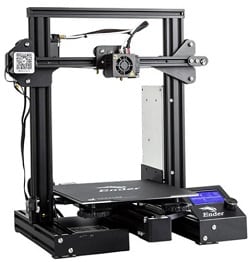
The printer is equipped with a proprietary Meanwell power supply, supports basic printing technologies, and can work with a wide range of materials.
The Y-axis guide is reinforced, the platform is equipped with a magnetic sticker that eliminates additional adhesives.
Technical specifications:
- printing technology - FDM, FFF, PJP;
- materials used - ABS, Flex, Nylon, PLA, Wood, PETG, SBS, Carbon Fiber;
- camera type - open;
- dimensions of the working space (W? H? D) - 220? 250? 220 mm;
- print speed - 180 mm / s;
- number of extruders - 1;
- printing accuracy X, Y - 0.1 mm;
- features - display, USB connection, micro SD slot;
- device dimensions (W? H? D) - 440 × 440 × 465 mm;
- weight - 6.9 kg.
Advantages
- high build quality and materials;
- convenient printing table;
- good print quality;
- possibility to change parameters.
Flaws
- unfriendly menu;
- the need for careful calibration before work;
- Not the clearest assembly instructions.
Creality3D Ender 3
The Creality3D Ender 3 compact 3D printer delivers decent print results with precision that rivals products printed on more expensive machines.
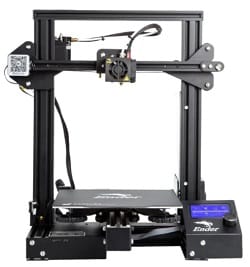
The device is equipped with an open chamber for printing, one printhead, a module for heating the working platform.
If necessary, the user can change the nozzle.
The connection is made via a standard USB interface. You can also set the characteristics of the model using a memory card.
Technical specifications:
- printing technology - FDM, FFF, PJP;
- materials used - ABS, PLA, Wood;
- camera type - open;
- dimensions of the working space (W? H? D) - 220? 250? 220 mm;
- print speed - 180 mm / s;
- number of extruders - 1;
- printing accuracy X, Y - 0.1 mm;
- features - table heating, display, active cooling, the ability to change the nozzle, USB connection, micro SD slot;
- device dimensions (W? H? D) - 440 × 465 × 420 mm;
- weight - 6.9 kg.
Advantages
- ease of assembly;
- adequate price;
- high quality printing;
- clear instructions.
Flaws
- noisy cooling fan
- lack of auto-calibration;
- there is no option to update the firmware.
Creality3D Ender 5
The Creality3D Ender 5 3D Printer stands out for its highest printing precision, which is achieved by dual Y and Z motors that run smoother and with fewer points of failure.
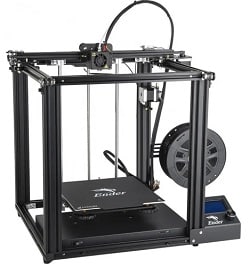
In case of an emergency blackout, printing can be resumed from the last layer.
Cables, circuit boards, modules and other components integrated into the internal controls are tested for safety under high loads.
The manufacturer guarantees the stability of work with continuous printing for 200 hours.
Technical specifications:
- printing technology - FDM, FFF, PJP;
- materials used - ABS, PLA, Wood;
- camera type - open;
- dimensions of the working space (W? H? D) - 220? 300? 220 mm;
- print speed - 180 mm / s;
- number of extruders - 1;
- printing accuracy X, Y - 0.1 mm;
- features - table heating, display, USB connection, SD slot;
- device dimensions (W? H? D) - 552 × 510 × 485 mm;
- weight - 11.8 kg.
Advantages
- nice design;
- stable work;
- high build quality;
- good print quality.
Flaws
- high price;
- not the highest print speed;
- not the smallest model.
Anycubic Mega-S
The Anycubic Mega-S model, equipped with amazing functionality, prints using FDM technology, the principle of which is the layer-by-layer production of bulk plastic products.
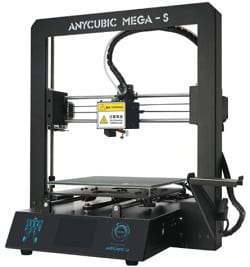
The device is reliably protected in case of an unexpected power outage - after the power supply is restored, it will continue to work from where it stopped.
The upgraded extruder, in turn, is equipped with a reliable spool mount and allows you to choose non-standard types of plastic.
Technical specifications:
- printing technology - FDM, FFF, PJP;
- materials used - ABS, PLA, Wood, HIPS;
- camera type - open;
- dimensions of the working space (W? H? D) - 210? 205? 210 mm;
- print speed - 100 mm / s;
- number of extruders - 1;
- printing accuracy X, Y - 0.002 mm;
- features - table heating, display, speed control, USB connection, SD slot;
- device dimensions (W? H? D) - 405 × 453 × 410 mm;
- weight - 11 kg.
Advantages
- performance out of the box;
- simple and understandable accompanying software;
- reliable table-base, durable hard case;
- price-quality ratio.
Flaws
- noisy work;
- poor cooling;
- slow printing.
Flash Forge Finder
The FlashForge Finder 3D printer comes fully assembled, the device is ready to work immediately after installation, the user only needs to make a few settings.
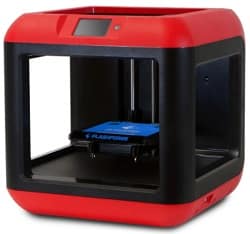
This makes the device safe for use by both adults and children.
The presence of an intelligent calibration system means quick and easy use of the printer, without complicated preparation and setup for printing.
A convenient 3.5-inch touch display with all the necessary elements and a 3D model display allows you to control and manage the process.
Technical specifications:
- printing technology - FDM, FFF, PJP;
- materials used - PLA;
- camera type - closed;
- dimensions of the working space (W? H? D) - 140? 140? 140 mm;
- print speed - 120 mm / s;
- number of extruders - 1;
- printing accuracy X, Y - 0.011 mm;
- features - display, Wi-Fi / USB-A connection;
- device dimensions (W? H? D) - 420 × 420 × 420 mm;
- weight - 20 kg.
Advantages
- excellent build quality;
- high printing accuracy;
- convenient software support;
- supplied assembled.
Flaws
- high price;
- low print speed;
- impressive dimensions and weight.
The best industrial and professional models
Large and expensive professional devices if desired can be used by beginners in 3D modeling.
Anycubic Photon S
The compact Anycubic Photon S model, focused on professional use, has expanded basic functionality, higher accuracy and a number of additional options.
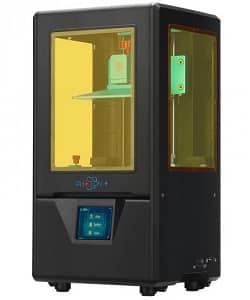
The z-axis of this device is more stable due to the use of a special guide system, the aluminum drawn wire platform increases the adhesion of the first layers for stability.
Technical specifications:
- printing technology - LCD;
- materials used - photopolymer;
- camera type - closed;
- dimensions of the working space (W? H? D) - 65 × 155 × 115 mm;
- print speed - 20 mm / s;
- number of extruders - 1;
- print accuracy X, Y - 0.047 mm;
- features — display, USB connection;
- device dimensions (W? H? D) - 230? 400? 200 mm;
- weight - 6 kg.
Advantages
- strong aluminum platform;
- there is an air filtration system;
- quiet work;
- Excellent value for money and quality.
Flaws
- low print speed;
- no connection "over the air";
- not the friendliest software environment.
Wanhao Duplicator 8
Wanhao Duplicator 8 professional 3D printer is an advanced 3D printing model with high modeling accuracy.
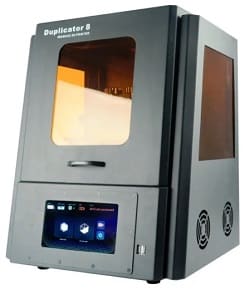
The device is made in a closed metal case, the top panel of which is equipped with windows for safe monitoring of the process.
The device is controlled using the touch screen. The device is equipped with a Wi-Fi module and a built-in slicer.
Technical specifications:
- printing technology - DLP;
- materials used - photopolymer;
- camera type - closed;
- dimensions of the working space (W? H? D) - 192? 180? 120 mm;
- printing speed (layer building) — 30 mm/h;
- number of extruders - 1;
- printing accuracy X, Y - 0.005 mm;
- features - display, temperature control, Wi-Fi / USB connection;
- device dimensions (W? H? D) - 450? 450? 600 mm;
- weight - 22 kg.
Advantages
- large volume of printing;
- simplicity and reliability of the design;
- convenience of the interface;
- affordable cost.
Flaws
- Insufficient manufacturer documentation for customization;
- there is no possibility of resuming work after a power outage;
- The printer is quite noisy.
Tiertime UP mini 2 ES
An improved version of the popular Tiertime UP mini 2 3D printer has received improved technical specifications and advanced software.
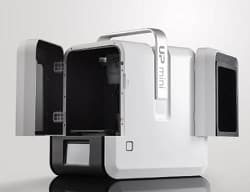
The device stands out for the ability to set the order of jobs, control via touch screen, options for updating the system, editing the IP address, saving jobs for later printing.
Technical specifications:
- printing technology - FDM, FFF, PJP;
- materials used - ABS, Nylon, PLA, ASA, PETG, Carbon Fiber, PC;
- camera type - closed;
- dimensions of the working space (W? H? D) - 120? 120? 120 mm;
- print speed - 200 mm / s;
- number of extruders - 1;
- printing accuracy X, Y - 0.005 mm;
- features - table heating, display, the ability to change the nozzle, Wi-Fi / USB-A / Ethernet connection;
- device dimensions (W? H? D) - 255? 365? 385 mm;
- weight - 7.5 kg.
Advantages
- convenient print queue option Tiertime;
- clear touch control;
- wide opportunities for connection;
- there is an auto-adjustment of the nozzle height;
- compatibility with third party materials.
Flaws
- high price tag;
- not very detailed user manual.
3D Systems CubeX Duo
The professional 3D Systems CubeX Duo model with two printheads is designed to create volumetric two-color models of impressive size.
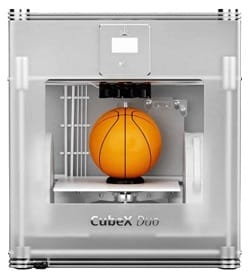
The device stands out for its ease of use, intuitive interface, high print accuracy, and the presence of a Wi-Fi module for over-the-air control.
There are two CubeX series extruders, customized Cubify Invent software.
Technical specifications:
- printing technology - FDM, FFF, PJP;
- materials used - ABS, PLA;
- camera type - open;
- dimensions of the working space (W? H? D) - 230? 240? 265 mm;
- print speed - 15 mm / s;
- number of extruders - 2;
- printing accuracy X, Y - 0.2 mm;
- features - display, Wi-Fi / USB connection;
- device dimensions (W? H? D) - 515? 598? 515 mm;
- weight - 37 kg.
Advantages
- stylish design;
- powerful reliable case;
- informative display;
- two print heads.
Flaws
- low speed of work;
- the unit is massive and overall;
- the price corresponds to the level of the printer.
Flash Forge Creator Pro
The FlashForge Creator Pro professional 3D printer highlights the optimal ratio of price, functionality and quality of the output products.
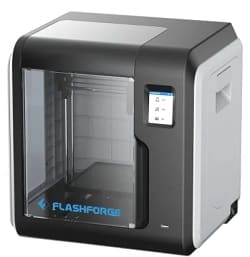
Monitoring and control of the process are carried out by means of a built-in tilting display.
The printer works with different types of plastic, but the best result is achieved when using PLA.
It is possible to print with separate composite materials.
Technical specifications:
- printing technology - FDM;
- materials used - ABS, PLA, PETg, HIPS, NYLON, WOOD, COOPER, SBS, FLEX, PVA;
- camera type - closed;
- dimensions of the working space (W? H? D) - 227? 148? 150;
- print speed - 40-100 mm / s;
- number of extruders - 2;
- printing accuracy X, Y - 0.1-0.4 mm;
- features - table heating, USB connection, display;
- device dimensions (W? H? D) - 480? 338? 385;
- weight - 21 kg.
Advantages
- two printheads;
- flexible and understandable settings;
- a wide range of materials used;
- high build quality of the printer.
Flaws
- noisy cooling system;
- there is no possibility of working with high-temperature plastic and fiberglass.
What items can be 3D printed?
On 3D printing devices theoretically, you can get any products, from small parts and toys to working prototypes of equipment and sculptures.
However, anyone can make a model according to their own sketches on a 3D printer.
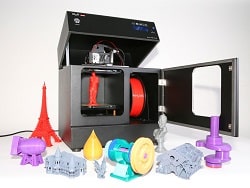
- rapid prototyping.
Prototyping, the rapid creation of prototypes or working models to demonstrate or test the feasibility of implementation; - complex geometry.
Production of products of any shape, color, size, repetition accuracy of which depend on the capabilities of the printer and the user's skills.
How a 3D Printer Works
The principle of operation of a 3D printer consists in superimposing layers of material on top of each other in the direction from bottom to top until a copy of the original object is obtained.
Process waste is automatically removed from the working platform.
The printer is controlled through the built-in touch screen.

Varieties of 3D printing technologies and their features
Home and professional printers The most commonly used technologies are:
- FDM (Fused Deposition Modeling) - the most common option with layer-by-layer construction of an object from a molten plastic thread.
Finished products are quite strong and have layering of varying degrees.
Variations of this technology are PJP (Plastic Jet Printing) and FFF (Fused Filament Fabrication). - PolyJet - layer-by-layer construction with curing of the photopolymer material by exposure to UV radiation.
Finished objects stand out for their smooth surfaces and high level of detail. SLM (Selective Laser Melting) - selective sintering of metal powders by means of a laser.
The most popular metal 3D printing technology.- DLP (Direct Light Projection) - selective curing of the polymer material due to the light emitted by the projector with a DLP matrix.
Used in Wanhao printers.
Differences between professional models and devices for home use
First of all it is:
- print accuracy — professional 3D printers correspond to the declared characteristics, head positioning is carefully calibrated at the factory;
- repeatability - several dozen copies of the object printed on a professional device will be identical, a 3D printer for the home will not be able to provide such accuracy;
lifetime - professional 3D printers work without serious breakdowns from 7 to 10 years, problems with home models can arise after 1-2 years of active use;
- materials – professional models are able to work with high-strength, heat-resistant, transparent and other materials.
Home models are usually limited in raw materials to plastic thread.
Reviews
This review has no replies yet.
Conclusion
- Occupation 3D modeling requires the purchase of fairly expensive 3D printing equipment.
- When choosing a 3D printer withIt is necessary to take into account its scope, technologies and materials used, design features.
- Professional equipment is more expensive, but gives a much better result.than amateur 3D printers for the home.
Useful video
This video provides an overview of the TOP 10 3D printers from China in 2024:


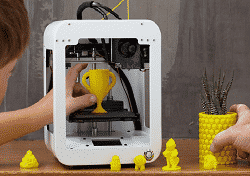 Camera type.
Camera type.  Number of extruders.
Number of extruders. SLM (Selective Laser Melting) - selective sintering of metal powders by means of a laser.
SLM (Selective Laser Melting) - selective sintering of metal powders by means of a laser.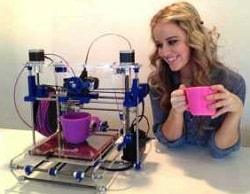 lifetime - professional 3D printers work without serious breakdowns from 7 to 10 years, problems with home models can arise after 1-2 years of active use;
lifetime - professional 3D printers work without serious breakdowns from 7 to 10 years, problems with home models can arise after 1-2 years of active use;